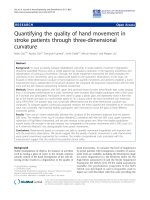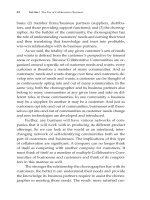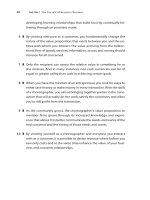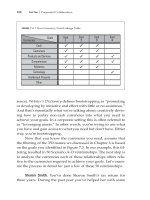Manipulation of source-sink relationship in pearl millet through growth retardants
Bạn đang xem bản rút gọn của tài liệu. Xem và tải ngay bản đầy đủ của tài liệu tại đây (258.24 KB, 11 trang )
Int.J.Curr.Microbiol.App.Sci (2020) 9(3): 2963-2973
International Journal of Current Microbiology and Applied Sciences
ISSN: 2319-7706 Volume 9 Number 3 (2020)
Journal homepage:
Original Research Article
/>
Manipulation of Source-Sink Relationship in Pearl Millet Through
Growth Retardants
P. R. Patel, G. M. Parmar and S. K. Parmar*
Pearl Millet Research Station, Junagadh Agricultural University,
Jamnagar-361 006 (Gujarat) India
*Corresponding author
ABSTRACT
Keywords
Pearl millet, PGRs,
Mapiquet Chloride,
Chloromequet
chloride
Article Info
Accepted:
25 February 2020
Available Online:
10 March 2020
The present study was carried out to understand the effect of foliar spray of
plant growth retardant substances on different growth parameter of pearl
millet under rainfed condition. Results indicated that foliar spray of plant
growth retardants at tillering and post-anthesis stage influenced growth and
yield attributing traits viz., grain yield, ear head weight, total dry matter,
threshing index, harvest index, test weight, number of effective tillers were
significantly higher or it was statistically at par with treatment of
chloromequet chloride @ 250 ppm when compare to other treatments.
Significantly less number of days 50% flowering and days to maturity were
observed in foliar spray of chloromequet chloride @ 250 ppm at tillering
and post-anthesis stage. Finally, the treatment chloromequet chloride @
250 ppm is better compare to other treatments which produced highest
grain yield with high benefit cost (B: C) ratio of 2.78.
Introduction
Pearl millet is the sixth most important and
widely grown potential cereal crop in the
world and is the fourth in India, after rice,
wheat and maize. Pearl millet is a short day
C4 type warm weather crop, it is endowed
with a very high photosynthetic efficiency.
Pearl millet is not only a quick growing short
duration crop, but also found drought as well
as heat tolerant and well adapted to different
soil types. Because of its propensity for high
dry matter production at high temperature, it
has made a mark in tropics and sub-tropics. It
is also rich in vitamin A, vitamin B, thiamin
as well as riboflavin contents and imparts
substantial energy to the body with easy
digestibility (Pal et al., 1996).
It is considered as whole crop utilization - a
source of grain for human consumption and
fodder for livestock (Gill 1991). Foliar spray
of different PGRS and nutrients influence
various developmental processes like number
2963
Int.J.Curr.Microbiol.App.Sci (2020) 9(3): 2963-2973
of leaves, number of effective tillers, along
with yield. Foliar spray of plant growth
regulators and nutrients used in appropriate
concentrations at appropriate time can play an
important role in better plant growth and
higher yield. Thus PGRs plays diverse role in
improving the physiological efficiency
including the photosynthetic ability of plants
and plays a significant role in enhancing the
source-sink relationship, thereby stimulates
the translocation of photoassimilates and
enhance productivity of the crops. (Solaimalai
et al., 2001).
Plant growth regulators are known to
influence the growth and development at very
low concentrations but inhibit the plant
growth
and
development
at
high
concentrations (Sasse 1997). Plant growth
retardants, particularly onium compounds
(e.g. CCC) and triazole compounds (e.g.
PBZ), are able to increase the partitioning of
assimilates to roots and thereby improve yield
through the inhibition of gibberellin
biosynthesis or action (Mansuroglu et al.,
2009). In addition, they can be used to control
excessive vegetative growth and to increase
quality attributes such as dry matter and
starch content of the harvestable organ.
Phytohormones play an important role both in
inducing and enhancing various physiological
activities in the plant. Synthetic growth
regulators which include promoters as well as
inhibitors may play a significant role in
increasing the yield of the crops by increasing
the efficiency in translocation and source sink
relation. Many growth retardants are known
to reduce the internodal length, reducing the
plant height and there by influence the source
sink relationship and stimulate the
translocation of photosynthates towards sink.
The growth retardants viz., TIBA, cycocel and
mepiquat chloride were more beneficial in
terms of the translocation of photo-assimilates
towards developing reproductive parts
compared to growth promoters (Pankaj
Kumar et al., 2006). Application of growth
retardants may also enhance the chlorophyll
content of leaves which helps to increase the
functional life of the source for a longer
period leading to improved partitioning
efficiency and increased productivity.
Reduced plant height and increase in the
functional life of the source for a longer
period especially during grain filling stage in
pearl millet are essential for its higher
productivity. Growth retarding chemicals
such as Amo-1618, CCC (2-chloroethyl
trimethyl ammonium chloride) and Phosfon D
reduce the height of many plants, leaving, in
most cases, flowering and fruiting affected
(Cathey and Stuart 1961). Keeping all these in
views, an investigation was carried out to
study the effect of foliar spray of plant growth
retardant substances on different growth
parameter of pearl millet under rainfed
condition.
Materials and Methods
A field experiment on pearl millet hybrid
RHB 173 was conducted at Pearl Millet
Research Station, Junagadh Agricultural
University, Jamnagar during rainy season
2016 to 2018. The experiment was laid out in
randomized block design with four
replications and seven treatments including
untreated control (T1). The two growth
retardant substances each have three level
viz., chloromequet chloride (CCC) @ 250
ppm (T2), 500 ppm (T3) and 750 ppm (T4) and
mapiquet chloride (MC) @ 250ppm (T5), 500
ppm (T6), 750 ppm (T7) were applied as foliar
spray at tillering and post-anthesis stage. The
gross plot size was 5.0 m 2.4 m (four row of
five meters length) and net plot size was 4.0
m 1.2 m (two row of four meters length).
All the recommended agronomical practices
and plant protection measures were followed
for raising a good crop. The observations viz.,
grain yield, fodder yield, dry ear head weight
2964
Int.J.Curr.Microbiol.App.Sci (2020) 9(3): 2963-2973
and total dry matter yield were noted on net
plot basis and converted in to kg ha-1. The
field observations viz., days to 50 per cent
flowering, days to maturity and 1000 grain
weight were recorded on plot basis while,
number of effective tillers, plant height and
total chlorophyll content at 70 DAS were
made on five randomly selected plants in each
treatment plots. Third leaf from the top was
collected for the estimation of total
chlorophyll content (ppm). The analysis of
variance was done as suggested by Panse and
Sukhatme (1985). The threshing index and
harvest index were calculated using following
formula;
Threshing
index (%)
Harvest index
(%)
=
Grain yield (kg)
Dry ear head
weight (kg)
100
=
Economic yield
(kg)
Biological yield
(kg)
100
Results and Discussion
The data pertaining to effect of foliar spray of
growth retardant substances on different
yield, growth and physiological parameters of
pearl millet are presented in table 1 to 3. The
significant difference was found among the
treatments during the individual year 2016,
2017 and 2018 on all the traits except total
dry matter during 2017. In pooled analysis,
also found significant difference among the
treatments on most of all the traits except total
dry matter, number of effectives tiller and
total chlorophyll content.
The significantly highest grain yield (2173
and 2672 kg ha-1) was recorded with foliar
spray of chloromequet chloride @ 250 ppm
(T2) during 2016 and 2018, respectively
whereas, in 2017 the foliar spray of
chloromequet chloride @ 500 ppm (T3)
recorded the highest grain yield (3475 kg ha-1)
and it was at par with the treatments T2, T4
and T6. On the basis of pooled results, the
foliar application of chloromequet chloride @
250 ppm (T2) reported 45 percent higher grain
yield (2640 kg ha-1) over the control (1821 kg
ha-1) and it was at par with treatments T3
(2546 kg ha-1), T6 (2397 kg ha-1) and T7 (2239
kg ha-1). The similar results of the present
study have confirmation with the finding of
Sathiskumar et al., (2018) in grain yield due
to enhancement of growth attributing
characters like plant height, dry matter
production and number of tillers and yield
attributing characters like number of
productive tillers, ear head weight and also
the nutrient uptake by finger millet. Dawood
et al., (2012) observed that increase in kernel
yield and yield components of sunflower by
salicylic acid were due to the effect of
physiological and biochemical processes that
led to ameliorate in vegetative growth, active
assimilation and translocation from source to
sink.
In case of fodder yield, foliar spray of
mapiquet chloride @ 250 ppm (T5) recorded
significantly the highest fodder yield with
3593 kg ha-1 during 2016 and it was at par
with treatments T2, T3, T4 and T6 while,
untreated control (T1) observed highest fodder
yield (5173 and 3585 kg ha-1) during 2017
and 2018, respectively and it was at par with
treatments T3, T4, T5 and T6 during 2017. In
pooled data, untreated control (T1) was noted
highest fodder yield with 4024 kg ha-1 and it
was at par with remained all the treatments
except T7.
Application of chloromequet chloride @ 250
ppm (T2) was reported significantly higher ear
head weight (3300 and 3308 kg ha-1) during
2016 and 2018, respectively while the
treatment chloromequet chloride @ 500 ppm
(T3) reported higher ear head weight with
2965
Int.J.Curr.Microbiol.App.Sci (2020) 9(3): 2963-2973
4953 kg ha-1 but it remained at par with T2,
T4, T5 and T6 during 2017. On the basis of
pooled results, the foliar spray of
chloromequet chloride @ 250 ppm (T2)
produced significantly higher ear head weight
3736 kg ha-1 and it was at par with remained
all the treatments except control (3086 kg ha1
). Similar increase ear head weight was
reported by Doddamani et al., (2010) in
sunflower due to application of mapiquet
chloride, by Singh et al., (1993) in mung bean
and Brar et al., (1992) in chickpea due to
chloromequet chloride. This result was in
agreement by Amin et al., (2008) with spike
weight in wheat and Sathish kumar et al.,
(2018) ear head weight in finger millet.
The treatment T2 (chloromequet chloride @
250 ppm) recorded significantly higher total
dry matter yield (6869 and 6657 kg ha-1)
during 2016 and 2018, respectively. However,
it remained statistically equivalent to T1 and
T5 during 2016 and to T1 during 2018. The
foliar spray chloromequet chloride @ 750
ppm (T4) was observed highest (9446 kg ha-1)
during 2017 and treatment chloromequet
chloride @ 500 ppm (T3) in pooled analysis
but remained all the treatments were
statistically at par during 2017 as well as
pooled. This was earlier reported by
Jeyakumar and Thangaraj (1998) due to
application of CCC found to increase RUBP
carboxylase enzyme activity, photosynthesis
and dry matter partitioning in groundnut and
by Doddamani et al., (2010) in sunflower.
Ravinchandran and Ramaswami (1991) also
reported that the foliar spray of mepiquat
chloride, cycocel and TIBA significantly
increased the amount of dry matter production
in soybean.
The treatment of mapiquet chloride @ 500
ppm (T6) during 2016, chloromequet chloride
@ 500 ppm (T3) during 2017 and
chloromequet chloride @ 250 ppm (T2)
during 2018 as well as pooled analysis
significantly exhibited highest threshing index
(68.7, 70.2, 80.8 and 71.2 %), respectively.
However, it was statistically equivalent to T2
and T7 during 2016, remain all the treatments
without control during 2017, treatments T4, T5
and T7 during 2018 and T3, T5 T6 and T7 in
pooled.
The foliar application of chloromequet
chloride @ 250 ppm (T2) significantly
exhibited highest harvest index (31.6, 37.6,
40.1 and 36.4 %) during all the individual
year 2016, 2017, 2018 as well as pooled
results, respectively. The treatments mapiquet
Chloride @ 500 ppm (T6) during 2016 and
chloromequet chloride @ 500 ppm (T3)
during 2017 also reported significantly
highest harvet index (31.6 and 37.6 %) and it
was statistically at par with treatments T3 and
T7 during 2016, T6 and T7 during 2017, T5 and
T7 during 2017 and in pooled results T3, T6
and T7. Application of PGRs increases the HI
and yield (De and Haque, 1994). Increase
harvest index due to BR spray was also
reported by Umadevi (1998) in Sesamum and
Sivakumar (2000) in pearl millet.
The treatment chloromequet chloride @ 250
ppm (T2) during 2016 while, chloromequet
chloride @ 750 ppm (T4) during 2017 and
2018 as well as pooled data recorded
significantly the highest test weight 9.1 g, 8.7
g, 9.0 g and 8.8 g, respectively. However, it
remained statistically equivalent to T3 during
2017 and to T2, T3 during 2018 as well as to
T2 and T7 in pooled. Bhatia and Kaur (1997)
attributed the increase in the hundred seed
weight in mungbean to BR application. NAA
spray in chickpea positively alters the
translocation of assimilates from pod wall to
the grains (Bangal et al., 1983). Ravikumar
and Kulkarni (1988) pointed out that foliar
application of NAA significantly increased
the hundred seed weight in soybean. The
increased seed weight might be attributed to
increased mobilization of metabolites to the
2966
Int.J.Curr.Microbiol.App.Sci (2020) 9(3): 2963-2973
reproductive sinks. The increase in total
number of seeds and 100 seed weight with
growth retardant treatments may be due to
better translocation of photosynthates by
shortening the plant size. The efficiency of
translocation depends on the distance between
the source and sink and it is inversely related
i.e., shorter the distance, better will be the
translocation and vice versa (Patil and
Dhomne, 1997). The foliar spray of
chloromequet chloride @ 250 ppm (T2)
recorded significantly less number of days
(42, 43, 44 and 43) for 50 percent flowering
during individual year 2016, 2017 and 2018
as well as polled data, respectively and it was
at par with treatments T6 during 2017, 2018
and in pooled. Similar result was reported by
Sivakumar (2000) in pearl millet. Nitrate
reductase is the key enzyme related to
flowering process. The increased nitrate
reductase activity by the application of
salicylic acid (Rane et al., 1995) and
(Sarangthem and Singh 2003) might be the
reason for early flowering induction. Reduced
Indole-3-Acetic Acid Oxidase (IAAO)
activity and increased auxin content also
contributed to early flowering, which was
achieved by salicylic acid treatment. Salicylic
acid in sesame reduced the number of
flowering days as reported by Umadevi
(1998), Manikandan and Sathiyabama (2014)
and Sathis Kumar et al., (2018) in finger
millet.
In case of days to maturity, the application of
chloromequet chloride @ 250 ppm (T2)
reported significantly early maturity (75, 74
and 75) during 2016, 2017 and in pooled,
respectively while mapiquet chloride @
250ppm (T5) and it was at par with treatment
T6 during 2017, 2018 and in pooled.
However, it remained statistically equivalent
to T6 during 2016 and 2017 and to T3, T6
during 2019 as well as to T2, T5, T6 and T7 in
pooled data. The increased nitrate reductase
activity by the application of salicylic acid
(Rane et al., 1995 and Sathis Kumar et al.,
2018) might be the reason for the induction of
early maturity.
None of significant difference was observed
on number of effective tillers in pooled
analysis. Maximum (2.8) number of effective
tillers was recorded with the treatment
chloromequet chloride @ 250 ppm (T2) and
minimum (2.1) recorded under untreated
control (T1). The significantly decrease the
plant height due to foliar spray of growth
retardant substances in pearl millet during the
individual year as well as pooled. Minimum
plant height (166 cm) was observed under
treatment mapiquet chloride @ 750 ppm (T7)
it was at par with all the treatments except
untreated control (T1) which observed highest
(198 cm) plant height in pooled basis data.
Cycocel and mepiquat chloride are antigibberellin dwarfing agents, and foliar spray
of these may induce deficiency of gibberellin
in the plant and reduce the growth by
blocking and conversion of geranyl
pyrophosphate to coponyl pyrophosphate
which is the first step of gibberellins synthesis
(Moore, 1980). Maximum reduction in plant
height was observed in mepiquat chloride
treatments than any of other chemicals.
Morandi et al., (1984) observed logarithmic
relationship between stem shortening and
mepiquat chloride or CCC doses and
concluded that mepiquat chloride is more
active than CCC in reducing the stem length
and node number in soybean. In case of total
chlorophyll content, none of significantly
difference was observed during 2017 and in
pooled analysis. Maximum (3.38 ppm) total
chlorophyll content was reported under
treatment mapiquet chloride (MC) 750 ppm
(T7) whereas, minimum (2.67) recorded under
untreated control (T1). Kulkarni et. al. (1995)
and Zaky et. al. (1999) are of the same
opinion that uses of growth retardants play a
positive and significant role in increasing the
chlorophyll level in sunflower.
2967
Int.J.Curr.Microbiol.App.Sci (2020) 9(3): 2963-2973
Table.1 Effect of foliar spray of growth retardants on grain, fodder, ear head and total dry matter yield of pearl millet
Grain yield (kg ha-1)
Treatment
Fodder yield (kg ha-1)
Ear head weight (kg ha-1)
Total dry matter yield (kg ha-1)
2016
2017
2018
Pooled
2016
2017
2018
Pooled
2016
2017
2018
Pooled
2016
2017
2018
Pooled
T1
1602
1928
1934
1821
3314
5173
3585
4024
3148
3243
2867
3086
6462
8416
6452
7110
T2
2173
3075
2672
2640
3569
3586
3349
3501
3300
4599
3308
3736
6869
8185
6657
7237
T3
1901
3475
2261
2546
3257
4296
3119
3557
3155
4953
3044
3717
6412
9249
6163
7275
T4
1469
3036
2036
2180
3348
4756
2877
3660
2946
4690
2724
3453
6294
9446
5601
7114
T5
1491
2902
2139
2177
3593
4769
2972
3778
2964
4249
2813
3342
6557
9018
5785
7120
T6
1915
3050
2227
2397
3275
4494
3155
3641
2787
4418
3038
3414
6062
8912
6193
7056
T7
1588
2851
2278
2239
3023
4124
3039
3395
2537
4181
2988
3235
5560
8305
6027
6631
S.Em.±
69.7
178.9
70.6
145.6
119.4
303.9
64.6
198.3
90.4
252.3
64.1
197.5
150.5
394.3
113.9
261.9
C.D. at 5 %
207.1
531.6
209.9
448.8
354.6
903.1
192.1
611.1
268.5
749.5
190.4
608.5
447.2
NS
338.5
NS
8.0
12.3
6.4
10.3
7.2
13.6
4.1
10.5
6.1
11.6
4.3
9.3
4.8
9.0
3.7
7.1
C.V. %
Y
S.Em.±
95.4
129.8
129.3
171.5
C.D. at 5 %
293.8
400.1
398.4
528.3
S.Em.±
118.1
192.2
159.1
252.4
C.D. at 5 %
335.1
545.1
451.2
715.9
YT
2968
Int.J.Curr.Microbiol.App.Sci (2020) 9(3): 2963-2973
Table.2 Effect of foliar spray of growth retardants on threshing index, harvest index, test weight and days to
50 % flowering of pearl millet
Treatment
Threshing index (%)
Harvest index (%)
Test weight (g)
Days to 50% flowering
2016 2017 2018 Pooled 2016 2017 2018 Pooled 2016 2017 2018 Pooled 2016 2017 2018 Pooled
T1
50.9
59.5
67.5
59.3
24.8
22.9
30.0
25.9
7.4
6.9
6.9
7.0
46
47
50
48
T2
65.8
66.9
80.8
71.2
31.6
37.6
40.1
36.4
9.1
7.7
8.0
8.3
42
43
44
43
T3
T4
60.3
49.9
70.2
64.7
74.3
74.7
68.3
63.1
29.6
23.3
37.6
32.1
36.7
36.4
34.6
30.6
7.7
8.6
8.1
8.7
8.0
9.0
7.9
8.8
44
46
45
46
45
48
45
47
T5
50.3
68.3
76.0
64.9
22.7
32.2
37.0
30.6
7.9
7.7
7.6
7.7
47
47
52
48
T6
68.7
69.0
73.3
70.3
31.6
34.2
36.0
33.9
8.6
7.8
7.1
7.8
44
44
45
44
T7
62.6
68.2
76.2
69.0
28.6
34.3
37.8
33.6
8.9
7.7
7.7
8.1
45
45
47
46
S.Em.±
2.4
2.0
2.1
2.5
1.1
1.2
1.1
1.6
0.04
0.2
0.3
0.2
0.4
0.4
0.3
0.6
C.D. at 5 %
7.1
5.9
6.1
7.6
3.3
3.5
3.2
4.9
0.1
0.7
1.0
0.8
1.2
1.3
1.0
1.8
C.V. %
8.1
5.9
5.5
6.4
8.0
7.1
5.9
6.9
1.1
5.6
8.6
5.8
1.9
1.9
1.4
1.7
Y
S.Em.±
C.D. at 5 %
YT
1.6
5.0
1.0
3.1
0.2
0.5
0.4
1.2
S.Em.±
C.D. at 5 %
2.1
6.1
1.1
3.2
0.2
0.7
0.4
1.1
2969
Int.J.Curr.Microbiol.App.Sci (2020) 9(3): 2963-2973
Table.3 Effect of foliar spray of growth retardants on days to maturity, number of effective tillers, plant height at harvest
and total chlorophyll content at 70 DAS of pearl millet
Treatment
Days to maturity
Number of effective tillers (No.)
Plant Height (cm)
Total chlorophyll content (ppm)
2016
2017
2018
Pooled
2016
2017
2018
Pooled
2016
2017
2018
Pooled
2016
2017
2018
Pooled
T1
79
78
82
80
1.3
2.0
3.0
2.1
177
200
217
198
2.13
1.69
4.18
2.67
T2
75
74
78
75
2.3
3.0
3.0
2.8
172
173
188
178
2.20
2.87
3.93
3.00
T3
77
76
75
76
1.5
4.0
2.0
2.5
167
166
186
173
2.37
3.39
3.65
3.14
T4
77
76
80
78
2.0
3.0
3.0
2.7
173
164
172
170
2.52
3.51
3.70
3.24
T5
77
76
74
76
1.8
3.0
3.0
2.6
170
173
179
174
2.75
2.55
3.58
2.96
T6
76
75
75
75
2.0
4.0
2.0
2.7
161
160
188
170
3.01
2.78
3.71
3.17
T7
77
76
77
77
1.5
3.0
3.0
2.5
169
154
174
166
2.86
3.05
4.24
3.38
S.Em.±
0.4
0.4
0.6
0.8
0.2
0.3
0.3
0.3
1.4
5.5
4.3
4.7
0.03
0.03
0.07
0.26
C.D. at 5 %
1.3
1.2
1.7
2.5
0.6
0.8
0.8
NS
4.2
16.4
12.9
14.6
0.08
0.08
0.21
NS
C.V. %
1.1
1.1
1.5
1.2
23.3
18.4
19.8
20.2
1.7
6.5
4.6
3.5
2.20
1.91
3.66
3.02
Y
S.Em.±
0.5
0.2
3.1
0.1
C.D. at 5 %
1.7
0.6
9.6
0.5
S.Em.±
0.5
0.3
4.1
0.1
C.D. at 5 %
1.4
0.7
11.7
0.1
YT
2970
Int.J.Curr.Microbiol.App.Sci (2020) 9(3): 2963-2973
On the basis of economics, the results
indicated that maximum net return (Rs.
43963/ha) was obtain with foliar application
of chloromequet chloride @ 250 ppm (T2) at
tillering and post-anthesis stage along with
highest benefit cost (B: C) ratio 2.78 followed
by treatments T3 i.e. chloromequet chloride @
500 ppm (B: C ratio 2.60) and T6 i.e.
mapiquet chloride @ 500 ppm (B: C ratio
2.43).
From the present investigation it is evident
that foliar spray of plant growth retardants at
tillering and post-anthesis stage influenced
growth and yield attributing traits viz., grain
yield, ear head weight, total dry matter,
threshing index, harvest index, test weight,
number of effective tillers were significantly
higher or it was statistically at par with
treatment of chloromequet chloride @ 250
ppm when compare to other treatment.
The days to 50 percent flowering and days to
maturity were significantly lowest in foliar
spray of chloromequet chloride @ 250 ppm at
tillering and post-anthesis stage. Finally,
among the treatments chloromequet chloride
@ 250 ppm is better compare to other
treatments which produced highest grain yield
with high benefit cost (B: C) ratio of 2.78.
References
Amin, A. A., Rashad, E. M., Fatma, Gharib,
A. E. 2008. Changes in Morphological,
Physiological
and
Reproductive
Characters of Wheat. Australian
Journal of Basic and Applied Sciences.
2(2): 252-261.
Bangal, D. B., Deshmukh, S. N., and Patil. V.
A. 1983. Contribution of pod-wall in
grain development of chickpea (Cicer
arietinum L.) as influenced by foliar
application of growth regulators and
urea. Indian Journal of Plant
Physiology. 25(3): 292-295.
Bhatia, D. S. and Kaur, J. 1997. Effect of
homobrassinolide and humicil on
chlorophyll content, hill activity and
yield components in mungbean (Vigna
radiata
(L.)
Wilczek).
Phytomorphology. 47(4): 421-426.
Brar, Z. S., Deol, J. S. and Kual, J. N. 1992.
Influence of plant growth regulators on
growth, production and dry matter
partitioning in chickpea. International
Chickpea Newsletter. 27: 25-27.
Cathey, H. M. and Stuart, N. W. 1961.
Comparative growth-retarding activity
of Amo-1618, Phosfon, and CCC.
Botan. Gaz., 123: 51-57.
Dawood, M. G., Sadak, M. S, Hozayen, M.
2012. Physiological role of salicylic
acid in improving performance, yield
and some biochemical aspects of
sunflower plant grown under newly
reclaimed sandy soil. Australian
Journal of Basic and Applied Sciences.
6(4):82-89.
De, G. C. and Haque, F. 1994. Effect of bio
regulators in growth and yield of
summer IR 36 rice. Oryza. 31: 145-146.
Doddamani, M., Nagesh, A. B. and Chetti, M.
B. 2010. Effect of growth retardants on
morpho-physiological traits and yield in
sunflower.
Karnataka
Journal of Agricultural Sciences. 23(2):
347-349.
Gill, K. S. (1991). Pearl Millet and its
Improvement. ICAR publications, New
Delhi.
Rane, J., Karuna, Lakkineni, C., Ananda
Kumar P., Yash, Aboral P. 1995.
Salicylic acid protects nitrate reductase
activity of wheat leaves. Plant
Physiology and Biochemistry.
22(2):
119-121.
Jeyakumar, P. and Thangaraj, M. 1996. Effect
of mepiquat chloride on certain
physiological and yield characteristics
of groundnut (Arachis hypogaea L.).
Journal of Agronomy and Crop Science.
2971
Int.J.Curr.Microbiol.App.Sci (2020) 9(3): 2963-2973
176: 154-164.
Sarangthem, K., Singh T. H. N. 2003.
Efficacy of salicylic acid on growth,
nitrogen metabolism and flowering of
Phaseolus vulgaris. Crop Research. 26:
355-360.
Kulkarni, S. S., Chetti, M. B. and Uppar, D.
S. 1995. Influence of growth retardants
on
biochemical
parameters
in
sunflower. Journal of Maharashtra
agricultural universities. 29: 352-354.
Manikandan, A. and Sathiyabama, M. 2014.
Foliar application of salicylic acid
stimulates flowering and induce defense
related proteins in finger millet plants.
Universal Journal of Plant Science.
2(1): 14-18.
Mansuroglu, S., Karaguzel, O., Ortacesme, V.
and Sayan, M. S. 2009. Effect of
paclobutrazol on flowering, leaf and
flower colour of Consolida orientalis.
Pakistan Journal of Botany. 41:23232332.
Moore, T. C. 1980. Biochemistry and
Physiology of Plant Hormone, Narosja
publishing house, New Delhi, 107-131.
Morandi, E. N., Reggiardo, L. M. and
Nakayama, F. 1984. N, Ndimethylpiperdinium chloride (DPC) and 2chloroethyl
trimethyl
ammonium
chloride (CCC) effects on growth yield
and dry matter partitioning of soybean
plants growth under two environmental
conditions. Phyton. 44: 133-144.
Pal, M., Daka, J. and Rai, R. K. 1996.
Fundamentals
of
Cereal
Crop
Production. Tata Mc Grow Hill
Publishing Company Limited, New
Delhi.
Pankaj Kumar, Hiremath, S. M. and Chetti,
M. B. 2006. Influence of growth
regulators on dry matter production and
distribution and shelling percentage in
determinate
and
semi-determinate
soybean genotype. Legume Research.
29: 191-195.
Panse, V. G and Sukhatme, P. V. 1985.
Statistical methods for agricultural
workers. ICAR, New Delhi, India.
Patil, B. N. and Dhomne, M. B. 1997.
Influence of plant growth retardant on
yield and yield contributing characters
in sunflower. Journal of Maharashtra
Agricultural University. 22: 213-214.
Ravichandran, V. K. and Ramaswami, C.
1991. Source and sink relationship in
soybean as influenced by TIBA. Indian
Journal of Plant Physiology. 34: 80-83.
Ravikumar, G. H. and Kulkarni G. N. 1988.
Effect of growth regulators on seed
quality in soybean genotypes. Seeds and
farms. 14: 25-28.
Sasse, J. M. 1997. Recent progress in
brassinosteroid
research.
Plant
Physiology.100: 696-701.
Sathish
kumar,
A.,
Sakthivel
N.,
Subramanian, E., Kalpana, R., Janaki,
P. and Rajesh, P. 2018. Foliar
application of nutrients and plant
growth regulators on growth and yield
of
finger
millet.
Journal
of
Pharmacognosy and Phytochemistry.
7(3): 3032-3035.
Sivakumar, R. 2000. Physiological studies on
increasing yield potential in pearl millet
(Pennisetum glaucum (L.) R.Br.) with
plant growth regulator and chemicals.
M.Sc. (Ag.) Thesis, Tamil Nadu
Agricultural University, Coimbatore.
Singh, J., Kavel, J. N. and Brar, Z. S. 1993.
Compartmentation of canopy, dry
matter and seed yield of summer
mungbean in relation to irrigation and
cycocel regimes. Indian journal of
pulses research. 6: 207-209.
Solamani, A., Sivakumar, C., Anbumani, S.,
Suresh, T. and Arumugam. K. (2001).
Role of plant growth regulators on rice
production:
A
review.
Agricultural Reviews. 23:33-40.
Umadevi, T. K. 1998. Studies on
physiological basis of partitioning and
2972
Int.J.Curr.Microbiol.App.Sci (2020) 9(3): 2963-2973
its regulation for maximizing yield in
Sesamum (Sesamum indicum L.). M.Sc.
(Ag.), Thesis, Tamil Nadu Agricultural
University, Coimbatore.
Zaky, L. M., El-Bahay, M. M., Dowidar, A.
E. and Latif, H. H. 1999. Some
physiological studies on the effect of the
growth retardants (pix) on Vicia fuba
plants Egyptian. Journal of Physiology.
23: 335-354.
How to cite this article:
Patel. P. R., G. M. Parmar and Parmar. S. K. 2020. Manipulation of Source-Sink Relationship
in Pearl Millet Through Growth Retardants. Int.J.Curr.Microbiol.App.Sci. 9(03): 2963-2973.
doi: />
2973









